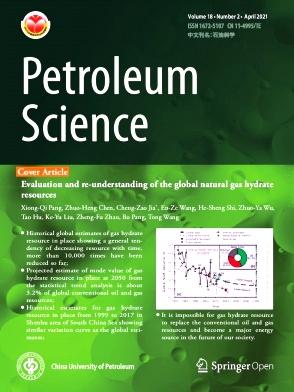利用基于晶粒的离散元方法研究异质糯米岩中水力断裂与砾石之间的相互作用行为
IF 6
1区 工程技术
Q2 ENERGY & FUELS
引用次数: 0
摘要
由于砾石的随机分布,糯米质储层具有很强的异质性,这给有效实施水力压裂带来了挑战。要解决这一问题,必须研究水力压裂(HF)与砾石之间的相互作用行为。本文采用基于晶粒的离散元方法,针对高频在砾岩中的传播提出了一种水力机械耦合模型。本文首先研究了高频在谷朊岩中的动态演化,然后分析了水平应力差(Δ)、最小水平应力()、砾石含量()、砾石粒度()以及砾石与基质的刚度比()等各种因素对高频传播几何形状的影响。结果表明,穿透砾石是高频与砾石相互作用的主要行为,遵循顺序和交错起始模式。绕过砾石是次要行为,遵循顺序启动模式,发生在砾石边界方向与最大水平应力()倾斜时。在穿透砾石时,通常会沿着砾石边界形成偏移,偏移可能导致断裂宽度减少 37.8%-84.4%。即使应力主导高频的传播方向,高频在砾石内部仍有偏移的趋势。与 Δ 的偏角随着 Δ 的增大而减小,并随着 Δ 和 Δ 的增大而增大。此外,在高Δ条件下,粗粒谷维岩中容易产生砾石内剪切高频(IGS-HFs),而在高Δ条件下,砾石绕过剪切高频(GBS-HFs)往往多于低Δ条件下的砂质谷维岩。上述发现提示了一种新的高频传播模式,有助于理解真实的高频几何形状,并为现场处理提供理论指导。本文章由计算机程序翻译,如有差异,请以英文原文为准。
Investigation of interaction behavior between hydraulic fractures and gravels in heterogeneous glutenite using a grain-based discrete element method
The glutenite reservoir is strongly heterogeneous due to the random distribution of gravels, making it challenging to perform hydraulic fracturing effectively. To solve this issue, it is essential to study interaction behavior between hydraulic fractures (HFs) and gravels. A coupled hydro-mechanical model is proposed for HF propagation in glutenite using a grain-based discrete element method. This paper first investigates the dynamic evolution of HFs in glutenite, then analyzes the influences of various factors such as horizontal stress difference (Δσ), minimum horizontal stress (σh), gravel content (Vg), gravel size (dg), and stiffness ratio of gravel to matrix (Rs) on HF propagation geometries. Results show that penetrating the gravel is the primary HF-gravel interaction behavior, which follows sequential and staggered initiation modes. Bypassing the gravel is the secondary behavior, which obeys the sequential initiation mode and occurs when the orientation of the gravel boundary is inclined to the maximum horizontal stress (σH). An offset along the gravel boundary is usually formed while penetrating gravels, and the offsets may cause fracture widths to decrease by 37.8%–84.4%. Even if stress dominates the direction of HF propagation, HFs still tend to deflect within gravels. The deviation angle from σH decreases with rising Δσ and increases with the increase of dg and Rs. Additionally, intra-gravel shear HFs (IGS-HFs) are prone to be generated in coarse-grained glutenite under high Δσ, while more gravel-bypassing shear HFs (GBS-HFs) tend to be created in argillaceous glutenite with high Rs than in sandy glutenite with low Rs. The findings above prompt the emergence of a novel HF propagation pattern in glutenite, which helps to understand the real HF geometries and to provide theoretical guidance for treatments in the field.
求助全文
通过发布文献求助,成功后即可免费获取论文全文。
去求助
来源期刊

Petroleum Science
地学-地球化学与地球物理
CiteScore
7.70
自引率
16.10%
发文量
311
审稿时长
63 days
期刊介绍:
Petroleum Science is the only English journal in China on petroleum science and technology that is intended for professionals engaged in petroleum science research and technical applications all over the world, as well as the managerial personnel of oil companies. It covers petroleum geology, petroleum geophysics, petroleum engineering, petrochemistry & chemical engineering, petroleum mechanics, and economic management. It aims to introduce the latest results in oil industry research in China, promote cooperation in petroleum science research between China and the rest of the world, and build a bridge for scientific communication between China and the world.
 求助内容:
求助内容: 应助结果提醒方式:
应助结果提醒方式:


